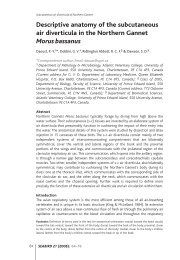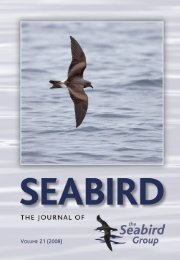Create successful ePaper yourself
Turn your PDF publications into a flip-book with our unique Google optimized e-Paper software.
2001 European Storm-petrel biology in Brittany 157<br />
Table 2. Breeding parameters for European Storm-petrel in north-west Europe.<br />
Tabel 2. Broedsucces van Stormvogeltjes in �oordwest-Europa.<br />
Hatching Fledging Breeding<br />
Colony Success (%) success a success b<br />
Mousa, Shetland (Bolton 1996) 86 0.71 0.61<br />
Skokholm, Wales (Davis 1957) 66 0.89 0.59<br />
Skokholm, Wales (Davis 1970) 55-68 0.49-0.78 0.27-0.50<br />
Enez Kreiz, Brittany (this study) 64-96 0.68-0.79 0.53<br />
Biarritz, SW-France (Hémery 1980) 64 0.90-1.00 0.62<br />
Benidorm, E-Spain (Minguez 1994) 70 0.90 0.63<br />
Range 55-96 0.49-1.00 0.27-0.63<br />
a for hatched eggs only; b overall breeding success<br />
the latest fledged in late October, or even perhaps occasionally <strong>No</strong>vember in<br />
very late years (although no visits were conducted at this time of the year).<br />
Given the marked increase in breeding numbers from 1997/98 to 1999,<br />
the potential effect of site history was also tested. <strong>The</strong>re was no significant<br />
difference between new sites (discovered in 1999) and old sites (occupied at<br />
least in 1998), but ‘new-old’ sites (occupied before, but not in, 1998) showed<br />
the lowest estimates for each of the three breeding parameters (Table 1;<br />
hatching success: χ 2 2 = 0.53, n.s., for minimum estimates and χ 2 2 = 1.57, n.s.,<br />
for maximum estimates, fledging success: χ 2 2 = 1.25, n.s., for minimum<br />
estimates and χ 2 2 = 0.68, n.s., for maximum estimates, breeding success χ 2 2 =<br />
1.60, n.s.).<br />
DISCUSSION<br />
Breeding parameters Recorded egg sizes in this study were in the same range<br />
as those noted by others (Cramp & Simmons 1977, Scott 1970). Data from<br />
elsewhere in north-west Europe indicate greater variability in hatching success<br />
and fledging success than in overall breeding success (Table 2). <strong>The</strong> estimates<br />
obtained in Brittany accord well with other data (Table 2). Regular observations<br />
made in 1999 have shown that, after breeding failure, unattended and unhatched<br />
eggs may remain for some weeks in the nest sites (up to at least 7 weeks), but<br />
that corpses of young chicks disappear more rapidly. Scott (1970) showed that<br />
most of the failures after hatching occurred within 48 hours, and most of the<br />
eggs that subsequently disappeared in 1999 were incubated for at least 3 to 6<br />
weeks (see Results). Thus, the higher estimates for hatching success are<br />
probably closer to the actual figures (maximum: 79-96% in Table 1), ranging








